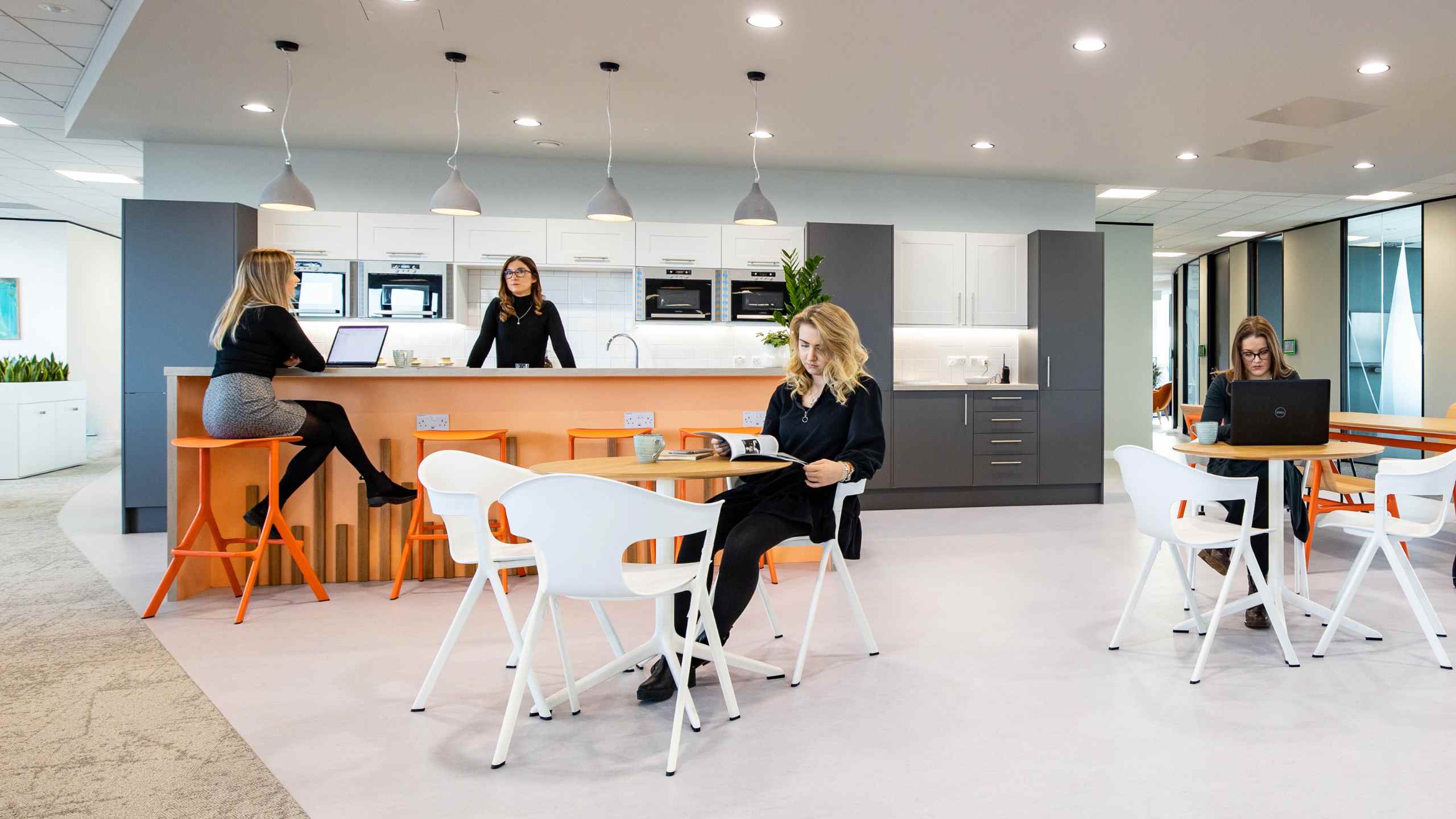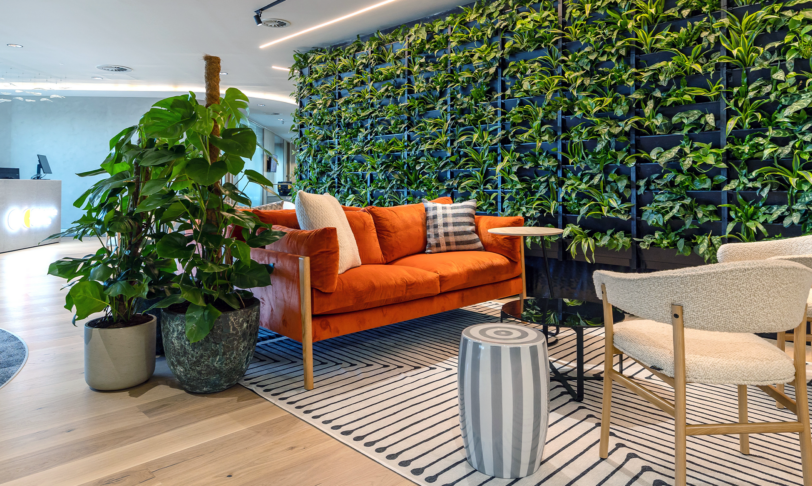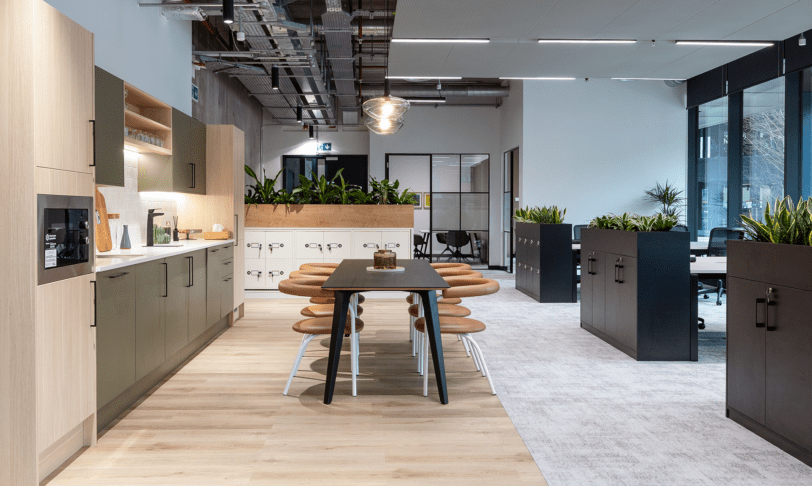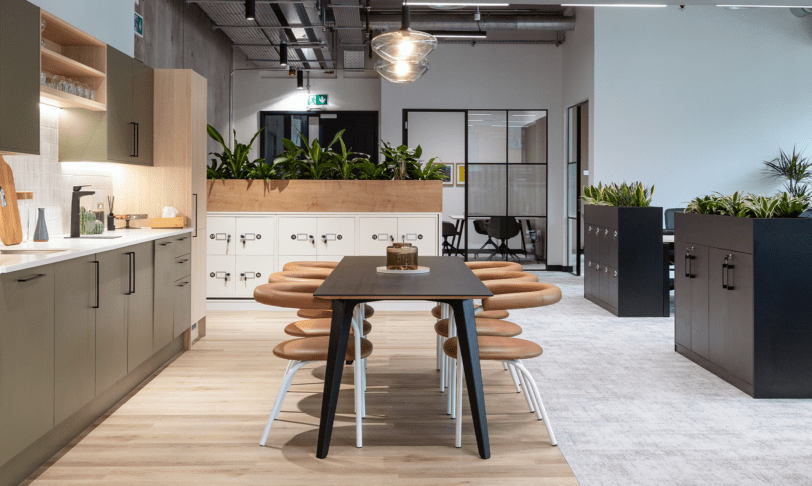Crafting an effective workplace strategy
The most exciting, attractive and efficient workplaces are more often than not the result of a carefully-considered workplace design strategy. If you’re interested in optimising your workplace to align with your organisational goals, this article will introduce you to the basic principles you’ll need to apply. And, as you’ll see, there’s far more to strategic workplace design than just flashy designs and comfy furniture.
What is a workplace strategy?
A workplace strategy is your roadmap to getting the best possible return on investment from the space you have. That doesn’t mean putting your employees into rows of cubicles where they’re supposed to “get on with the job” in isolation. Instead, the workplace is optimised to enhance performance, workplace engagement, and job satisfaction. In essence, the workplace becomes a destination where people feel like they can work at their very best. In parallel to this, your workplace strategy takes your vision, goals and company culture into account. The resulting design becomes an integral part of your organisation’s identity. We’ve outlined some of the main elements that comprise a workplace strategy below.
Spacing and layout
Spacing and layout are carefully considered, with a floorplan that facilitates the quick and efficient completion of tasks. The need for collaboration and creative spaces should also be a priority, allowing prompt problem-solving. Your workspace needs to be laid out with the things that matter most to your business’s success at the forefront.
Your strategic design can be flexible too. Form follows function, so if you’re frequently tackling new projects that require collaboration followed by focused work, the best solution may be flexible spaces that can be adapted to the needs of the moment. After all, the layout of your space can make or break the workplace experience.
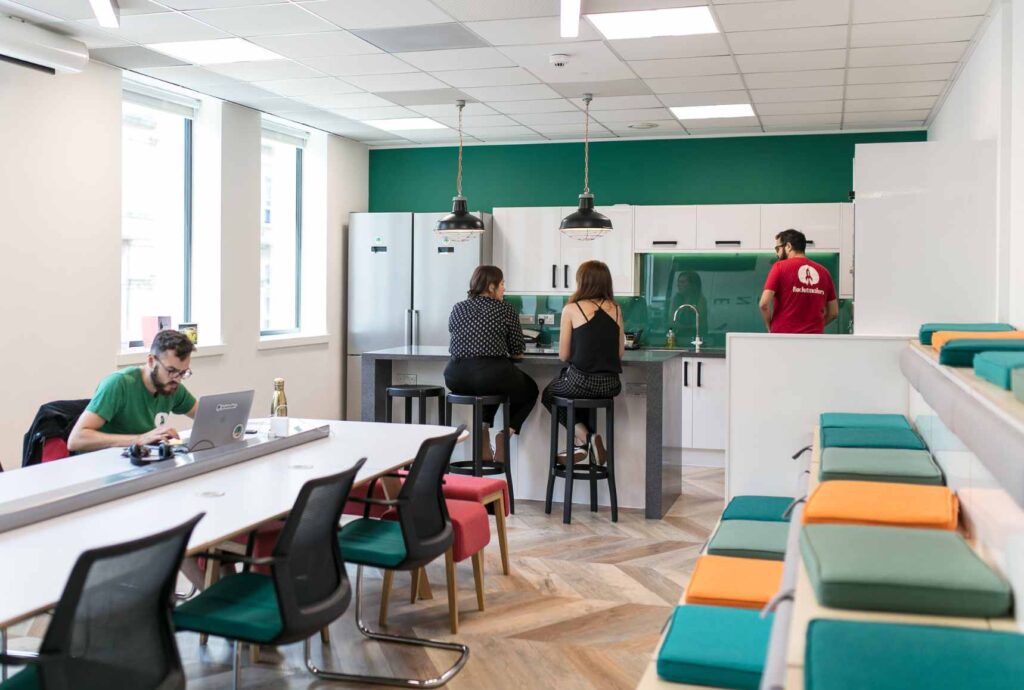
Furniture and amenities
As you’d expect, the various choices of furniture and amenities matter too. For instance, you could offer employees the option of moving to a standing desk, or a choice of zones (including quiet zones and collaborative ones) where they can do their work. For meetings, informal and formal options will set the tone, and extra amenities such as relaxation or prayer spaces can be pivotal for attracting and retaining the very best talent.
Technology
Technology has a role to play in the modern workplace strategy – and it’s more than just easy access to the printer. Hybrid work is a good example of how technology impacts workplace design. “Office days” are usually for collaboration and meetings, and they help your off-site workers to feel like they’re part of the business. Your workplace design and strategy are deciding factors in how much they look forward to those days at the office.
What are the different types of workplace strategies?
As you can imagine, a workplace strategy isn’t a one-size-fits-all solution. Strategies can vary drastically based on your needs, resources and goals. Here are just a few examples:
Workplace design strategy
A workplace design strategy examines your business’s strategic goals, culture, and work methods and incorporates them into the layout and design of the workplace. Common examples include spaces that enhance efficiency and collaboration, as well as stimulate innovation and creative thinking.
Workplace experience strategy
Every interaction between your employees and your business contributes to the overall workplace experience. While the workplace itself only forms part of that experience, and interpersonal relationships also matter, your design choices set the scene. Creating spaces where people love to work and that promote positive experiences encourages your employees to deliver their best. It starts right from the minute you enter the space, whether you’re an employee, client or candidate. From the way you’re greeted at reception to the way your needs are met within the space, all these factors combine to increase retention rates, reputation and commitment.
Workplace engagement strategy
A high level of employee engagement is known to have tangible benefits for the companies that foster it. Engaged employees have strong feelings of connection with the companies that employ them, and they’re ready to go the extra mile to promote their success. Welcoming workplaces that contain opportunities for focused solo work, collaboration, and connection make a big contribution towards employee engagement. Providing spaces for your employees to work in the way that suits them best and have autonomy is key to a productive workforce. Equally, ensuring your employees feel heard, valued and rewarded is crucial for a successful workplace engagement strategy. This can be achieved through thorough onboarding, pulse surveys, thought-through meetings, internal rituals and a great comms policy.
Workplace transformation strategy
A workplace transformation strategy brings together the elements we’ve discussed so far. Human-centred design is the starting point, and that includes considering how people work, connect, communicate, and interact within the workplace. Of course, technology has become an inescapable part of getting things done, so a workplace transformation strategy takes this into account too. Taking a fresh approach to organisational changes? The workplace should reflect your new strategic direction.
What are the key elements of a well-designed workplace strategy?
They’re driven by data
Strategic workplace decisions should be backed by data wherever possible. It’s not just a case of what designers think will work, or how you want to convey your brand. Instead, there are reliable facts to show how certain choices, be they design or other elements of the workplace, offer tangible, long-term benefits.
Their success can be measured
No strategy should be without clear goals and metrics to track progress. The choice of metrics depends on what you hope to achieve, but in this context, employee involvement, satisfaction, feedback, and experience would apply. And, with business outcomes offering you evidence of your workplace strategy’s success, you can set up KPIs aligned with your overall strategy to help you to see how it contributes to overall goals.
They’re people-focused
Every person offers something unique and valuable, so your workplace should be strategically designed to help them flourish. Creating an environment that supports a positive workplace experience helps people to perform better. It also fosters collaboration, creativity, and the birth of new ideas. People-focused design is practical, but it’s also energising and exciting.
They’re flexible and scalable
You’re on the lookout for new opportunities and projects, and you’re ready to be flexible and scale your resources to their requirements. But is your workplace able to keep up with your changing needs? With good design, it can. It should be possible to shuffle workstations at will or even create a temporary “town hall” space for company-wide meetings.
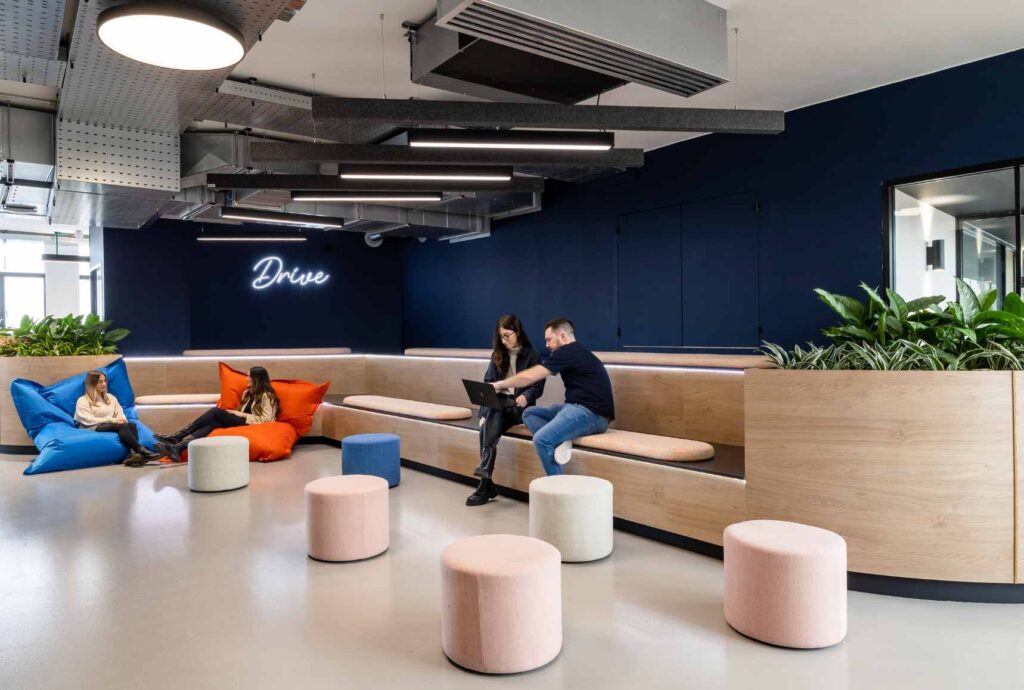
What are the benefits of a workplace strategy?
Your workplace design strategy can contribute to multiple goals that affect both insider perspectives and how outsiders view your brand. For example, you may have a strong green agenda and want your sustainable offices to reflect that. From an insider perspective, there’s a lot to gain too. Let’s look at that next.
Achieve higher levels of productivity
Having a workspace that’s designed with operational needs in mind makes getting things done easier. When that workspace is also designed for comfort, wellbeing, and health, an added layer of productivity comes on top of that. It’s not just possible to complete work, it’s enjoyable too. Check out our guide to Office Design & Productivity.
Better collaboration
Working in silos can be hugely unproductive. While there are times when people need to work on their own, having opportunities to collaborate helps them to work better as a team. They can coordinate projects, help each other when necessary, and share ideas that enhance results. With good design on their side, collaboration becomes par for the course.
Optimising available space
Does your space really work for you? It comes at a price, so making it work effectively contributes to your business’s profitability as well as its efficiency. Strategic design ensures that you can use your space as productively as possible, eliminating “dead” areas that rarely fulfil any function.
Attracting and retaining talented people
Sometimes companies who want to avoid the traditional ‘cubicle’ layout swing too far in the other direction, building open-plan offices where people may struggle to concentrate or work together without distractions. Strategically-designed, flexible workspaces provide the best of both worlds and eliminate their respective drawbacks. When those workplaces are beautiful, functional, and flexible, you have a destination workplace that attracts and retains talented people.
What should be considered when designing a workplace strategy?
Goals and objectives
Your workplace strategy must be framed around unique goals that make sense to your business. The workplace is the heart of all the activities that contribute to your company’s goals, so it figures that its design should take them into account and contribute to your team’s efforts.
Values and culture
Like all effective strategies, your workplace strategy begins with your company’s identity. Your business’s values and culture must be reflected in the workplace, and it must make a lasting positive impression that harmonises with the personality you want your business to convey.
Employee needs and requirements
As part of reaching your business objectives, your employees’ needs and requirements should be catered to. This calls for the data-driven, people-centric approach we previously touched on. Your strategy should be built around what your people do and how they do it, so your workspace brings out the best in them while also helping them maintain a positive work-life balance.
Future plans
Finally, you should look towards the future – how your business’s needs will change and any new activities that it may undertake in the not-too-distant future. When it’s time to bring those changes, your workplace strategy will already have determined how you can go about adapting your space without compromising any of the goals you realised when it was first designed.
Workplace strategy trends
Wondering what the latest trends in workplace strategy are? They’re informed by modern work methods and culture, and they could help to give you some inspiration when seeking out a design direction.
Hybrid working
Employees have the advantage of being able to work from home more now than ever before, and companies are coming around to the fact that this level of freedom and autonomy can save resources while enhancing results. But remote work has a major drawback: it’s hard to feel engaged with a company when your only connection with it is your computer screen. Hybrid work models strive to deliver the best of both in-office and at-home work, and as you’d expect, they’ve become a major workplace strategy trend.
Flexibility and adaptability
If your business is flexible and adaptable, you can take advantage of opportunities whenever they arise. But does your workplace strategy foster this? At different points in a project, and from project to project, you may need to adapt your workspaces to accommodate your changing activities. Today, it’s about collaboration and brainstorming. Tomorrow, it’s about focus and acting on the results of those sessions. A flexible workplace strategy allows you to adapt the space to suit your needs at any given time.
Sustainability
Employees want to work for organisations that support values that they can believe in. According to research from Deloitte, companies that take purposeful action on ethical questions such as sustainability have up to 40 percent better employee retention. Your commitment to sustainability becomes their commitment to furthering your business’s goals.
As a result, your workplace strategy should incorporate sustainable design wherever possible. From the choice of ‘green’ or recycled materials for office fitouts to the use of intelligent LED lighting, you can do your bit to help the planet while also engaging and inspiring your employees.
Creating “destination” workplaces
The battle for top talent is on, and the winner isn’t necessarily the company that’s able to offer the best salary and benefits. “Destination” workplaces offer prospective employees beautiful spaces that showcase the company’s dedication to employee wellbeing. They speak volumes about your company’s culture, and the message is irresistible. Your workplace isn’t just for people who want “a job.” Instead, it’s purposefully designed to attract people who want to work for you. That means a better chance of attracting and retaining the dedicated, skilled people that every employer wants.
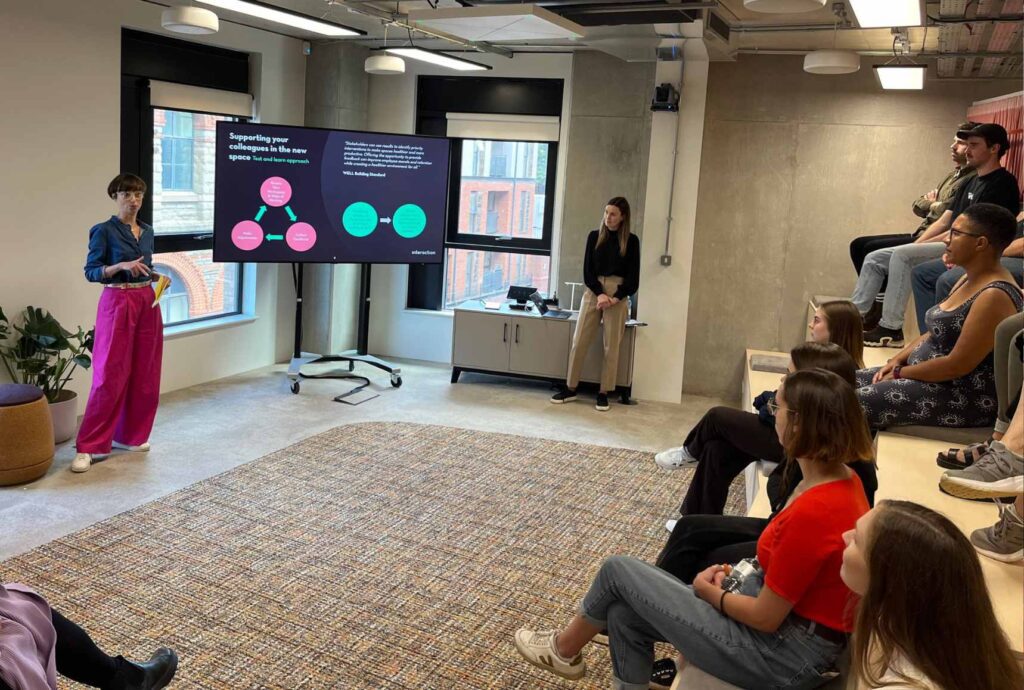
Creating compelling workplace strategies with Interaction
Every organisation has specific needs, requirements and measures of success. At Interaction, we channel these into an in-depth and bespoke workplace strategy that helps people perform at their absolute best. Our workplace strategies are incredibly varied, but here’s just a glimpse of what we can offer:
- Understanding employees: People are at the heart of what we do. We carry out extensive employee profiling and surveys with verbatim feedback, so companies get to grips with employees’ attitudes to their current workspace, their preferred methods of communication and how the work environment contributes to their overall wellbeing. We can also facilitate staff engagement workshops so that the workplace is designed around a cohesive vision that everyone wants to be a part of.
- Clear industry benchmarking: Want to know how your workplace stacks up against competitors? Our workplace assessments can include valuable insight into industry norms, giving you a well-rounded understanding of your overall Employee Value Proposition (EVP). Find out more in our guide about the role of EVP in attracting and retaining talent.
- Assessing workplace design and layout: It is our job to understand every aspect of how your workplace functions. Opportunities for improvement could be where you least expect it, so we try to be as granular and comprehensive as possible with our audits. These audits include your workplace’s technology, furniture, storage, acoustics, lighting, and even air quality. This will allow us to pinpoint exactly where your workplace can be optimised so that your team can do what they do best comfortably and free of unnecessary distractions.
- Commercial property expertise: We work closely with businesses and landlords to ensure they get their money’s worth from their properties. This can include real estate valuation, property portfolio recommendations, and guidance on how to attract a high-covenant commercial tenant. To find out more about attracting top tenants, check out our whitepaper: ‘Attracting Tenants: What Commercial Landlords Need to Know’.
- Visualisation and roadmaps: More often than not, we work with companies who have a decent grasp on what they achieve but just need a push to turn their ideas into action. We’ll take your strategies for ED&I, ESG, wellbeing or any other must-have initiatives, and turn them into a series of attainable goals so you have a clear and conceivable path to long-term success.
Are you ready to embark on formulating and executing a workplace strategy? Then it’s time for Interaction to step in. Getting help from experienced professionals will fast-track your journey towards the development and execution of a workplace strategy that’s as unique as your business. Why not chat with Charlie or call us on 01225 485 600 to speak to a member of our team?
